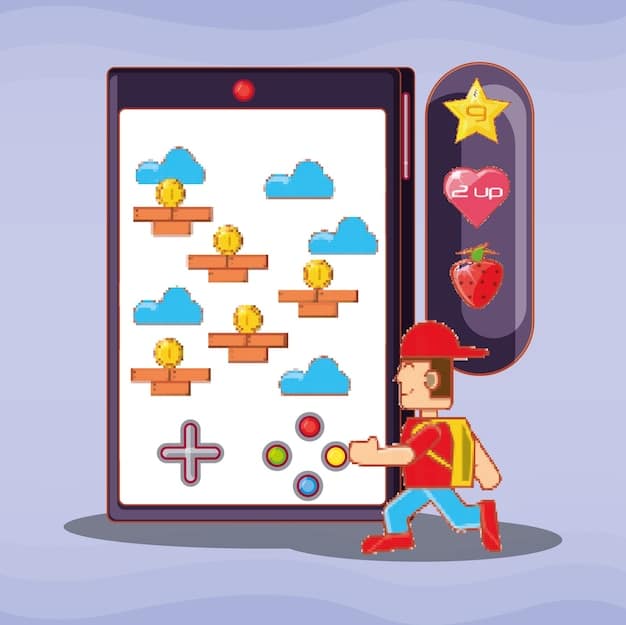Microtransactions: Are They Ruining the Gaming Experience?

Microtransactions, small in-game purchases, are increasingly prevalent in modern gaming, sparking debate over whether they enhance or undermine the gaming experience. This opinion piece delves into the ethics of these transactions, exploring their impact on gameplay, fairness, and the overall health of the gaming industry.
The gaming landscape has dramatically evolved, and with it, so has the way we consume and interact with our favorite digital worlds. One of the most significant changes, and arguably one of the most controversial, is the rise of **microtransactions**. Are they a necessary evil, keeping the industry afloat, or are they slowly eroding the core principles of fair play and immersive experiences?
The Evolution of Microtransactions in Gaming
Microtransactions weren’t always the ubiquitous feature they are today. Understanding their origins and how they’ve integrated into gaming provides crucial context for the current debate.
Initially, microtransactions appeared as seemingly harmless additions. Think of cosmetic items or small boosts in mobile games. These purchases offered convenience or personalization without drastically altering the gameplay balance. However, as the gaming industry evolved and business models shifted, microtransactions began to take on a more central role.
From Cosmetic Tweaks to “Pay-to-Win”
The shift from purely cosmetic items to gameplay-altering advantages marked a turning point. When players can purchase power-ups, exclusive weapons, or faster progression, the playing field becomes uneven. This “pay-to-win” model disadvantages those unwilling or unable to spend extra money, potentially leading to frustration and a sense of unfairness.
The Rise of Loot Boxes
Loot boxes, another form of microtransaction, added an element of gambling to the gaming experience. These virtual crates contain randomized rewards, often enticing players to spend money for a chance to obtain rare and powerful items. The lack of transparency regarding drop rates and the addictive nature of randomized rewards have drawn significant criticism and regulatory scrutiny.

Ultimately, the evolution of microtransactions reveals a complex interplay between game development, business strategies, and player experience. While not inherently negative, the increasing integration of these purchases into core gameplay loops raises ethical concerns about fairness, accessibility, and the potential for exploitation.
The Ethical Dilemma: Pay-to-Win and Predatory Practices
The ethics of microtransactions often hinge on whether they create an unfair advantage or exploit vulnerable players. Examining the practices of “pay-to-win” and other potentially predatory designs helps reveal the ethical dimensions of these in-game purchases.
The “pay-to-win” model is where microtransactions offer tangible advantages that directly affect gameplay. This can manifest as stronger equipment, faster leveling, or exclusive access to essential resources. In such scenarios, players who invest more money gain a competitive edge, undermining the skill-based foundation of the game.
The Psychology of Exploitation
Predatory practices in microtransactions often prey on psychological vulnerabilities. Game developers can design systems that exploit cognitive biases, such as loss aversion or the fear of missing out (FOMO). Limited-time offers, exclusive bundles, and aggressive marketing tactics can pressure players into making impulsive purchases they might later regret.
- Skinner Box Mechanics: Utilizing variable reward schedules to create addictive loops.
- Dark Patterns: Designing interfaces that trick users into making unintended purchases.
- Exploiting FOMO: Creating artificial scarcity to drive sales.
These ethical considerations raise serious questions about the responsibility of game developers and publishers. Should they prioritize profit over fairness and player well-being? Where is the line between offering convenience and exploiting vulnerabilities?
In conclusion, the ethical dilemma surrounding microtransactions is rooted in their potential to create unfair advantages and exploit players’ psychological vulnerabilities. A responsible approach requires transparency, moderation, and a commitment to player well-being over short-term financial gains.
Impact on Game Design and Player Experience
The increasing reliance on microtransactions has undeniably affected game design and, consequently, the overall player experience. Games are now often structured to encourage or even necessitate in-game purchases, leading to a fundamentally altered experience for many gamers.
One of the most significant consequences is the phenomenon of artificial difficulty curves. Game developers may intentionally create bottlenecks or grind-heavy sections to incentivize players to circumvent these challenges with purchased boosts or items. This can disrupt the natural flow of the game and diminish the sense of accomplishment.
The Balance Between Enjoyment and Frustration
Striking a balance between providing an enjoyable gaming experience and generating revenue through microtransactions is a delicate act. Some games successfully integrate these purchases without compromising the core gameplay, while others become bogged down in systems designed primarily to extract money from players.
- Creative Limitations: Focusing on monetization can stifle innovation and creativity.
- Community Division: Creating a divide between paying and non-paying players.
- Loss of Immersion: Constant prompts and offers can break the immersive quality of the game.
Furthermore, the constant presence of in-game stores and promotions can be distracting and immersion-breaking. Instead of fully engaging with the game world, players are constantly reminded of opportunities to spend more money. This can erode the sense of escapism and create a transactional atmosphere.

In summary, the impact of microtransactions on game design and player experience is complex and multifaceted. While they can contribute to a game’s longevity and provide ongoing revenue, they also have the potential to undermine enjoyment, create artificial difficulty, and alter the fundamental design principles upon which games are built.
The Developer Perspective: Sustainability vs. Greed
From the perspective of game developers and publishers, microtransactions often represent a necessary tool for sustaining and growing their businesses. The costs of game development have skyrocketed in recent years, making it increasingly difficult to recoup investments through traditional sales models alone.
Maintaining a live-service game, with ongoing updates, content additions, and community support, requires a steady revenue stream. Microtransactions can provide that stream, allowing developers to continue investing in the game and its community long after its initial release.
The Cost of Game Development
The financial realities of game development are often overlooked in discussions about microtransactions. AAA games can cost tens or even hundreds of millions of dollars to develop, and marketing budgets can be equally substantial. Microtransactions offer a way to offset these costs and ensure the financial viability of future projects.
Finding the Right Balance
Ultimately, the question of sustainability versus greed comes down to how microtransactions are implemented. Are they designed to enhance the player experience and provide genuine value, or are they simply a means of extracting as much money as possible?
In conclusion, the developer’s perspective highlights the financial pressures that drive the adoption of microtransactions. While they can be a valuable tool for sustaining game development and providing ongoing content, the line between sustainability and greed is often blurred. Striking a balance that benefits both developers and players requires transparency, ethical design, and a long-term vision.
Consumer Rights and Regulation: A Call for Transparency
As microtransactions become increasingly pervasive, the question of consumer rights and regulation gains importance. Players deserve transparency regarding the costs, odds, and potential impact of these in-game purchases. Without clear guidelines and protections, the potential for exploitation grows.
Many players feel powerless when faced with the complexities of microtransaction systems. Understanding their rights and advocating for stricter regulations could help create a fairer and more transparent gaming environment. This involves demanding clear disclosures about loot box probabilities, refund policies, and restrictions on marketing towards minors.
The Need for Clear Labeling
One crucial step towards protecting consumers is the implementation of clear labeling for games that contain microtransactions. Similar to ratings on movies or warnings on tobacco products, a prominent label can inform consumers about the presence of in-game purchases before they make a purchase.
- Advocating for Self-Regulation: Encouraging industry-led initiatives to set ethical standards.
- Supporting Government Oversight: Urging lawmakers to enact legislation that protects consumers.
- Educating Consumers: Providing resources that empower players to make informed decisions.
In addition to labeling, regulators could also consider implementing stricter oversight of loot box mechanics, particularly those targeting younger audiences. The randomized nature of these rewards, combined with the potential for addiction, has raised concerns about their similarity to gambling.
In short, the call for transparency and regulation of microtransactions reflects a growing recognition that players deserve greater protection and information. By advocating for stronger consumer rights and supporting responsible regulations, we can help create a gaming environment that’s both innovative and fair.
The Future of Gaming: Microtransactions or Something Else?
Looking ahead, the future of gaming remains uncertain. Will microtransactions continue to dominate the landscape, or will alternative monetization models emerge? The answer likely depends on how the industry addresses the ethical concerns and consumer demands outlined above.
One potential alternative is a shift towards subscription-based models, similar to those seen in streaming services. Players would pay a monthly fee for access to a library of games or exclusive content, eliminating the need for individual microtransactions. This model could create a more predictable revenue stream for developers while providing players with greater value and transparency.
Exploring Alternative Revenue Models
Beyond subscriptions, other alternative revenue models could gain traction. These might include crowdfunding, patronage systems, or even government funding for culturally significant games. The key is to explore innovative approaches that prioritize player experience and ethical practices.
- Focus on Quality: Prioritizing game design and player satisfaction over monetization.
- Embracing Innovation: Experimenting with new revenue models that align with player values.
- Building Community: Fostering a strong relationship between developers and players.
Ultimately, the future of gaming hinges on a willingness to challenge the status quo and prioritize player well-being over short-term profits. By embracing transparency, ethical design, and innovative revenue models, the industry can create a sustainable future that benefits both developers and players alike.
| Key Point | Brief Description |
|---|---|
| 💸 Pay-to-Win | Microtransactions that give players an unfair competitive advantage. |
| 🎲 Loot Boxes | Virtual crates with randomized rewards, often criticized for resembling gambling. |
| 🎮 Game Design Impact | Microtransactions can lead to artificial difficulty and a focus on monetization. |
| ⚖️ Regulation | There is an increasing call for transparency and regulation of microtransactions. |
FAQ
▼
Microtransactions are small in-game purchases that allow players to buy virtual items, currency, or other content using real money. They are common in free-to-play games, but also found in paid games.
▼
Not necessarily. Microtransactions that offer cosmetic enhancements or convenience without affecting gameplay fairness are generally considered less problematic. The controversy arises when they create a “pay-to-win” scenario.
▼
“Pay-to-win” refers to games where players can purchase advantages that significantly impact their ability to succeed. This can include stronger equipment, faster progression, or exclusive access to powerful abilities.
▼
Loot boxes are virtual items that contain a random assortment of in-game rewards. Players purchase them with real money or in-game currency, but the contents are unknown until opened, adding an element of chance.
▼
Voice your concerns to game developers and publishers, support advocacy groups pushing for regulation, and make informed purchasing decisions. Consider supporting games with ethical monetization models.
Conclusion
In conclusion, the debate over whether **microtransactions** are killing gaming is complex and multifaceted. While they can provide a sustainable revenue stream for developers, they also have the potential to undermine fairness, exploit vulnerabilities, and alter the fundamental principles of game design. A balanced approach, with transparency, ethical design, and a focus on player well-being, is essential to ensuring a healthy and vibrant future for the gaming industry.





